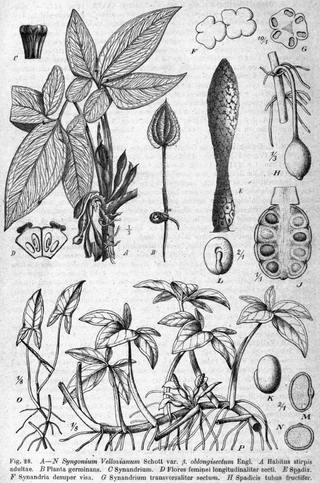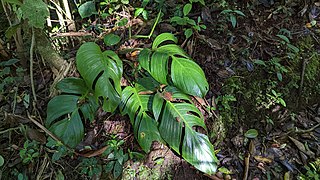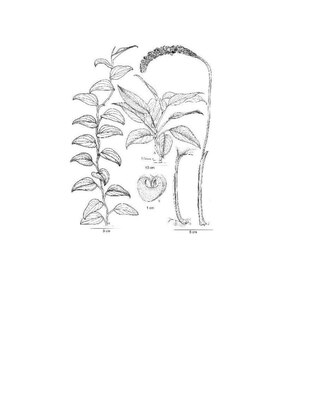
Syngonium is a genus of flowering plants in the family Araceae, native to tropical rainforests in southern Mexico, the West Indies, Central and South America. They are woody vines growing to heights of 10–20 m or more in trees. They have leaves that change shape according to the plant's stage of growth, and adult leaf forms are often much more lobed than the juvenile forms usually seen on small house plants. The scientific name of the genus comes from the Greek words σύν and γονή and refers to the fused ovaries of female flowers.

Monstera deliciosa, the Swiss cheese plant or split-leaf philodendron is a species of flowering plant native to tropical forests of southern Mexico, south to Panama. It has been introduced to many tropical areas, and has become a mildly invasive species in Hawaii, Seychelles, Ascension Island and the Society Islands. It is very widely grown in temperate zones as a houseplant.

Monstera is a genus of 59 species of flowering plants in the arum family, Araceae, native to tropical regions of the Americas.

Dioscorea trifida is a species of flowering plant in the family Dioscoreaceae. It is a species of yam. It is native to the Caribbean and Central and South America. Its many common names include Indian yam, cush-cush, and yampee. It is called mapuey in Venezuela, inhame in Brazil, tabena and ñame in Colombia, sacha papa in Peru, and ñampi in Costa Rica.

Epipremnum is a genus of flowering plants in the family Araceae, found in tropical forests from China, the Himalayas, and Southeast Asia to Australia the western Pacific. They are evergreen perennial vines climbing with the aid of aerial roots. They may be confused with other Monstereae such as Rhaphidophora, Scindapsus and Amydrium.

Monstera epipremnoides is a species of flowering plant in the family Araceae, endemic to Costa Rica. A clone in cultivation was formerly thought to be of this species, but after comparison with wild populations of M. epipremnoides, the plant in cultivation has since been registered as a cultivar of the name Monstera 'Esqueleto'.

Monstera punctulata is a species of flowering plant from the family Araceae found in the southern part of Mexico and in Central America.

Eucalyptus nandewarica, commonly known as mallee red gum, is a species of tree or mallee that is endemic to a small area of western New South Wales. It has mostly smooth bark, lance-shaped adult leaves, flower buds in groups of three or seven, white flowers and cup-shaped or hemispherical fruit.

Corymbia kombolgiensis, commonly known as scarp gum or paper-fruited bloodwood, is a species of small tree that is endemic to the Northern Territory. It has smooth bark, sometimes with rough, tessellated bark near the base, linear to narrow lance-shaped adult leaves, flower buds usually in groups of seven, white flowers and cylindrical to barrel-shaped fruit.
Monstera tacanaensis is a species of flowering plant in the genus Monstera of the arum family, Araceae.

Monstera acacoyaguensis is a flowering plant in the family Araceae and the genus Monstera, section Monstera. its native range is Mexico (Chiapas) to Belize, at altitudes below 200 meters. As an adult, it grows as an epiphyte. Juvenile plants grow as terrestrial creepers, and undergo dramatic morphogenesis upon reaching a suitable climbing surface. Adult plants have green, smooth petioles 40-65 centimeters long, with adaxially glossy, leathery, ovate leaf blades that rapidly truncate to the petiole, 60-85 centimeters long and 35-45 centimeters wide. Its fenestrations are numerous, ovate, and mostly originate mid-rib, sometimes in two to three rows. These perforations curl adaxially, and are 2-5 centimeters wide and 4-12 centimeters long. Monstera acacoyaguensis has a light yellow to cream-colored spathe, 25-30 centimeters wide and 25-35 centimeters tall. Its spadix is yellow and cylindric, 1.5-2 centimeters wide and 18-22 centimeters long. Its seeds have not been described. It has been described as having an unusually persistent spathe, lasting up to 20 days at maturity in comparison to other monstera, who only flower for two to three days. M. acacoyaguensis is also notable because, unlike most other monstera, it naturally grows in conditions of full sunlight.

Monstera barrieri is a flowering plant of the genus Monstera and family Araceae.
Monstera juliusii is a flowering plant in the family Araceae. It is native to high-altitude cloud forests of Costa Rica at altitudes of 1,600 to 2,250 metres and occasionally confused with Monstera standleyana. However, M. standleyana has green petioles, few fenestrations and thin leaves, while M. juliusii is characterized by mottled white petioles, frequent fenestrations at maturity and thick, leathery leaves. Mature plants have pinnatilobed leaves as long as 60 cm and 30 cm wide, with circular fenestrations close to the margins, and oval fenestrations near the midrib. The species is named after Julius Johnson, son of the artists Rashid Johnson and Sheree Hovsepian.

Monstera lechleriana is a flowering plant in the genus Monstera in the arum family, Araceae. It is native to Bolivia, Colombia, Ecuador, Panamá, Peru, and Venezuela. The species is named for the German botanist Willibald Lechler, who collected the original type specimen in 1854. It was the scientifically described by Heinrich Wilhelm Schott by 1860. Like other Monstera, the plant is an epiphytic climbing vine which grows on the lower trunks of trees, and which produces large leaves with leaf windows when mature that appear on each side of the midrib of the foliage.
Monstera limitaris is a flowering plant in the genus Monstera of the arum family (Araceae).

Monstera monteverdensis is a species of flowering plant in the arum family, Araceae. Its adult form is characterized by pinnatifid margins with up to eight lobes per side, with occasional fenestrations away from the midrib. Leaves can grow as large as 60 cm long and 30 cm wide. It is named after the city of Monteverde, where the species is abundant.

Monstera gambensis is a species of plant in the family Araceae. It is endemic to the tropical forest of La Gamba, Golfito, Costa Rica at 100m elevation. They can be found on the floor of humid forests with their stems climbing up trees and aerial roots visible above the soil. Sometimes the entire plant can be found solely on trees. M. gambensis is typically not fenestrated until the adult stage, but can have two perforations on their blade.
Monstera alfaroi is a flowering plant in the arum family. It is endemic to mid-altitude premontane rainforests of Costa Rica at altitudes of 1,100 to 1,250 metres. M. alfaroi features light brown petioles with black or white warts. It is closely related to Monstera buseyi, but M. alfaroi can be distinguished by its larger inflorescence. M. alfaroi is also easily confused with M. costaricensis, which can be distinguished from M. alfaroi by its petioles with white pustules, more conical inflorescence, and location; M. costaricensis only occurs in lowland areas of Costa Rica below 600 metres (2,000 ft). Mature plants have ovate leaf blades as long as 90 centimetres (35 in) and 45 centimetres (18 in) wide, with few circular fenestrations near the midrib. From petiole to blade tip, M. alfaroi leaves can be up to 160 centimetres (63 in) long. It has a white spadix and an externally light green spathe. Flowering has been recorded in November, and fruiting in January.

Philodendron opacum is a species of flowering plant. It has a native range extending from Southeast Nicaragua to Ecuador and includes Colombia, Costa Rica, Ecuador, Nicaragua, Panama. Its habitat is largely restricted to the Tropical Wet Forest and Premontane Wet Forest life zones in Central America, but in South America extends into Premontane Rain Forest (Colombia) and Tropical Moist Forest (Ecuador).














